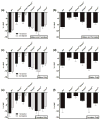Cardiovascular effects of exogenous adrenomedullin and CGRP in Ramp and Calcrl deficient mice
- PMID: 27940069
- PMCID: PMC5706544
- DOI: 10.1016/j.peptides.2016.12.002
Cardiovascular effects of exogenous adrenomedullin and CGRP in Ramp and Calcrl deficient mice
Abstract
Adrenomedullin (AM) and calcitonin gene-related peptide (CGRP) are potent vasodilator peptides and serve as ligands for the G-protein coupled receptor (GPCR) calcitonin receptor-like receptor (CLR/Calcrl). Three GPCR accessory proteins called receptor activity-modifying proteins (RAMPs) modify the ligand binding affinity of the receptor such that the CLR/RAMP1 heterodimer preferably binds CGRP, while CLR/RAMP2 and CLR/RAMP3 have a stronger affinity for AM. Here we determine the contribution of each of the three RAMPs to blood pressure control in response to exogenous AM and CGRP by measuring the blood pressure of mice with genetic reduction or deletion of the receptor components. Thus, the cardiovascular response of Ramp1-/-, Ramp2+/-, Ramp3-/-, Ramp1-/-/Ramp3-/- double-knockout (dKO), and Calcrl+/- mice to AM and CGRP were compared to wildtype mice. While under anesthesia, Ramp1-/- male mice had significantly higher basal blood pressure than wildtype males; a difference which was not present in female mice. Additionally, anesthetized Ramp1-/-, Ramp3-/-, and Calcrl+/- male mice exhibited significantly higher basal blood pressure than females of the same genotype. The hypotensive response to intravenously injected AM was greatly attenuated in Ramp1-/- mice, and to a lesser extent in Ramp3-/- and Calcrl+/- mice. However, Ramp1-/-/Ramp3-/- dKO mice retained some hypotensive response to AM. These results suggest that the hypotensive effect of AM is primarily mediated through the CLR/RAMP1 heterodimer, but that AM signaling via CLR/RAMP2 and CLR/RAMP3 also contributes to some hypotensive action. On the other hand, CGRP's hypotensive activity seems to be predominantly through the CLR/RAMP1 heterodimer. With this knowledge, therapeutic AM or CGRP peptides could be designed to cause less hypotension while maintaining canonical receptor-RAMP mediated signaling.
Keywords: Adrenomedullin; Blood pressure; CGRP; Calcrl; Hypotension; RAMP.
Copyright © 2016 Elsevier Inc. All rights reserved.
Figures



Similar articles
-
Receptor activity-modifying protein-dependent effects of mutations in the calcitonin receptor-like receptor: implications for adrenomedullin and calcitonin gene-related peptide pharmacology.Br J Pharmacol. 2014 Feb;171(3):772-88. doi: 10.1111/bph.12508. Br J Pharmacol. 2014. PMID: 24199627 Free PMC article.
-
Probing the Mechanism of Receptor Activity-Modifying Protein Modulation of GPCR Ligand Selectivity through Rational Design of Potent Adrenomedullin and Calcitonin Gene-Related Peptide Antagonists.Mol Pharmacol. 2018 Apr;93(4):355-367. doi: 10.1124/mol.117.110916. Epub 2018 Jan 23. Mol Pharmacol. 2018. PMID: 29363552 Free PMC article.
-
Structure-function analysis of amino acid 74 of human RAMP1 and RAMP3 and its role in peptide interactions with adrenomedullin and calcitonin gene-related peptide receptors.Peptides. 2011 May;32(5):1060-7. doi: 10.1016/j.peptides.2011.03.004. Epub 2011 Mar 22. Peptides. 2011. PMID: 21402116
-
Shared and separate functions of the RAMP-based adrenomedullin receptors.Peptides. 2011 Jul;32(7):1540-50. doi: 10.1016/j.peptides.2011.05.022. Epub 2011 May 27. Peptides. 2011. PMID: 21645567 Review.
-
Regulation of cardiovascular development and homeostasis by the adrenomedullin-RAMP system.Peptides. 2019 Jan;111:55-61. doi: 10.1016/j.peptides.2018.04.004. Epub 2018 Apr 22. Peptides. 2019. PMID: 29689347 Review.
Cited by
-
Genetic analysis of over 1 million people identifies 535 new loci associated with blood pressure traits.Nat Genet. 2018 Oct;50(10):1412-1425. doi: 10.1038/s41588-018-0205-x. Epub 2018 Sep 17. Nat Genet. 2018. PMID: 30224653 Free PMC article.
-
Characterization of Antibodies against Receptor Activity-Modifying Protein 1 (RAMP1): A Cautionary Tale.Int J Mol Sci. 2022 Dec 16;23(24):16035. doi: 10.3390/ijms232416035. Int J Mol Sci. 2022. PMID: 36555690 Free PMC article.
-
Elucidating the Interactome of G Protein-Coupled Receptors and Receptor Activity-Modifying Proteins.Pharmacol Rev. 2023 Jan;75(1):1-34. doi: 10.1124/pharmrev.120.000180. Epub 2022 Dec 8. Pharmacol Rev. 2023. PMID: 36757898 Free PMC article. Review.
-
Meningeal lymphatic CGRP signaling governs pain via cerebrospinal fluid efflux and neuroinflammation in migraine models.J Clin Invest. 2024 May 14;134(15):e175616. doi: 10.1172/JCI175616. J Clin Invest. 2024. PMID: 38743922 Free PMC article.
-
Meningeal lymphatic drainage: novel insights into central nervous system disease.Signal Transduct Target Ther. 2025 May 5;10(1):142. doi: 10.1038/s41392-025-02177-z. Signal Transduct Target Ther. 2025. PMID: 40320416 Free PMC article. Review.
References
-
- Hinson JP, Kapas S, Smith DM. Adrenomedullin: a multifunctional regulatory peptide. Endocr Rev. 2000;21(2):138–167. - PubMed
-
- Wimalawansa SJ. Calcitonin gene-related peptide and its receptors: molecular genetics, physiology, pathophysiology, and therapeutic potentials. Endocr Rev. 1996;17(5):533–585. - PubMed
-
- Marutsuka K, et al. Immunohistological localization and possible functions of adrenomedullin. Hypertens Res. 2003;26(Suppl):S33–40. - PubMed
-
- Nishikimi T, et al. Chronic administration of adrenomedullin attenuates transition from left ventricular hypertrophy to heart failure in rats. Hypertension. 2003;42(5):1034–1041. - PubMed
-
- Rademaker MT, et al. Beneficial hemodynamic and renal effects of adrenomedullin in an ovine model of heart failure. Circulation. 1997;96(6):1983–1990. - PubMed
MeSH terms
Substances
Grants and funding
LinkOut - more resources
Full Text Sources
Other Literature Sources
Research Materials

